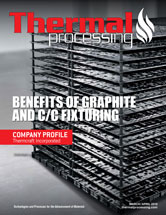Introduction
Pyrometry, as it relates to heat treat, Nadcap, and AMS2750E does not embody the traditional definition of ‘pyrometry.’ Regardless, AMS2750E has been placed as the Aerospace Industry Standard to control thermocouples, furnace testing, and related quality requirements. In this essay we will briefly explore the necessary steps to understand the requirements of AMS2750E and the separate requirements of Nadcap which are put forth in the Nadcap Pyrometry Guide.
Pyrometry – how important?
I am a metallurgical engineer. I’ve worked about 50/50 R&D and production processing. This has provided me with what I believe is well-rounded experience in heat-treat and related thermal processing. As a specific example, I have seen the effects that a non-thermally uniform furnace can have on the metallurgical results in a laboratory. During development of a diffusion braze process, I had five samples distributed throughout a vacuum furnace; one in the center and one in each corner. The sample in the back-left corner had a dissimilar diffusion phase and, consequently, smaller solid solution loops in the braze joint. In the end, this makes for not only a less homogeneous microstructure between the hardware processed but presents a much higher opportunity for re-melt in service. The furnace itself should have a ±10°F tolerance — although once tested, it was found to be ±32°F with the back-left corner being -32°F from set-point.
Stating the importance of pyrometry, negating Nadcap requirements, and looking at this from a laboratory point of view is not the hard part. If AMS2750E were employed strictly from a results-based laboratory perspective, the importance of pyrometry is dependent on the sensitivity of the process itself. For example, a simple stress relieves of 4340 bar stocks in an air furnace is not nearly as sensitive as, say, a braze cycle of small circular joints. From an engineering point of view, pyrometry typically is not going to be the largest variable in most processes we work with. Braze joint size, filler material, temperature, time, ramp rates, and atmosphere are all typical examples of what engineers dwell on during development of a processes; not pyrometry.
For those of us who have Nadcap requirements flowed down to us, it is important. It’s almost an entirely different aspect of quality engineering regarding any thermal process it applies to. In the end, AMS2750E, when invoked by Nadcap flow down from customers, becomes top priority for engineering and quality since it has been the largest source of Nadcap heat-treat findings.
New to NADCAP & AMS2750E
Throughout my consulting career, I have been approached by many companies who had attempted to get their initial Nadcap accreditation in heat-treat on their own. Typically, these companies have experienced less than satisfactory results. I’ve seen multiple reasons for this, from lack of knowledge regarding heat-treat processing, incorrect interpretation of the checklists, to the most common reason — poor knowledge and execution of pyrometry requirements. Pyrometry requirements typically make up 70 percent of all Nadcap heat-treat findings in a single year. If you’re new to Nadcap, then you are most likely new to pyrometry, and I would recommend retaining the services of an experienced engineer who is familiar with pyrometry.
Understanding AMS2750E
As with any specification, it must be read carefully. It would do no good to read the specification and attempt to implement it if you do not understand the material. Put another way, on a scale of 1 to 10, with 1 indicating zero knowledge of pyrometry, someone reading AMS2750E for the first time would need to be at least a 5 in order to properly comprehend and implement the AMS2750E specification.
Most quality engineers are familiar with the term ‘bubbling’ as it relates to blue prints. Bubbling a print is a practice in which each requirement is assigned a sequential number. Once this is done on the print, it is then logged onto a form which contains the designated number, its associated requirements, the subsequent result, and an accept/reject notice. Typically, this is done on machined parts that may have an intermediate process (such as heat-treat) involved in their manufacture. When an intermediate process is performed, the specification is simply listed as the requirement and an accept designation is applied. The specification itself is not bubbled, but read by an engineer, and the applicable requirements flowed down.
My method is to bubble the specification itself. Take each requirement out of the specification and assign it a sequential number. Let’s call them ‘characteristic requirements.’ Some paragraphs may have several requirements within a single paragraph; each would be separated and assigned its own sequential number. Let’s look at an example of this:
AMS2750E PG 19, PARA 3.4.5.1:
“The displayed temperature indication and/or recording of the sensor being tested as used in production, with appropriate offsets or correction factors, at any operating temperature, shall be compared with the corrected temperature indication of the test sensor on a test instrument.”
It may seem that a single requirement is being put forward; but there are actually seven contained within this one paragraph.
- The displayed temperature indication…
- and/or recording of the sensor being tested…
- as used in production…
- with appropriate offsets or correction factors [option for either]…
- at any operating temperature…
- shall be compared with the corrected temperature indication of the test sensor…
- on a test instrument.
I have performed this task on both AMS2750D and AMS2750E. Revision E ended with 513 characteristic requirements, including tables and figures. Once bubbled, each requirement must be accounted for as they apply to your operations. For example, any requirement regarding a retort furnace would be designated ‘N/A’ if your operation employed only vacuum furnaces. Of course, the continuing issue of comprehension arises at each step of this process. If you have a poor understanding of pyrometry, it will be difficult to bubble AMS2750E, and nearly impossible to successfully complete the process of showing conformance. Training is an important step in this process.
Summary
In the end, ensure your comprehension of AMS2750E is in line with Nadcap’s expectations and that your internal auditing system is sound. This will expedite your success in implementing AMS2750E as it applies to Nadcap.































